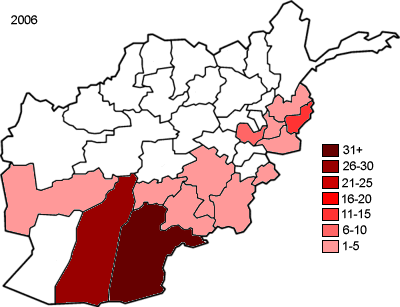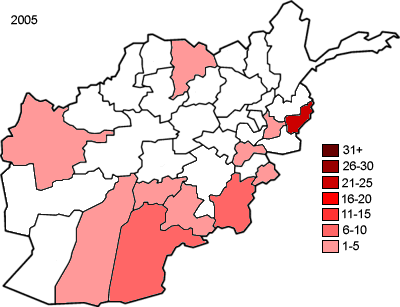October 25, 2006
NATO occupation ratios in Afghanistan
The Prof. Paris piece I link two posts below makes some statements about occupation ratios, and it's also relevant to the Henley-driven update, so here's the NATO troop-to population ratios in the five NATO regional commands, including Kabul, as of October:
RC South
(Cdn-UK-NL-Aus-Den-Rom)
2.8 million Afghans
9,800+ troops
equals >3.5 soldiers per 1000 inhabitants;
RC East
(US)
6.7 million Afghans
10,000 troops
1.5 per 1000
RC North
(Ger-Swe-Nor)
6.3 million Afghans
2,700 troops
0.4 per 1000
RC West
(Ita-Spn-US)
2.9 million Afghans
1,800 troops
0.6 per 1000
RC Kabul
(UK-Fra)
3.0 million Afghans
6,500 troops
2.2 per 1000.
Note that the Kabul number, because of its high tail-to-tooth ratio in Kabul and Bagram, is obviously a little inflated, there.
For comparison purposes, the US+allies troop-to civilian occupation ratio in Iraq is roughly 6 per 1000.
There is also a good 2002 map showing Afghan population densities worth referring to here.
Bush: never the diplomat, is he?
President Bush, today:
This month we've lost 93 American service members in Iraq, the most since October of 2005. During roughly the same period, more than 300 Iraqi security personnel have given their lives in battle."
To clarify, up to the point of Bush's remarks the October toll was 90 American service members, 1 Brit, 1 Dane, and 1 Salvadoran (source: icasualties.org). I'd like to say all three of the non-Americans would have appreciated Bush's honorary auto-induction into the U.S. armed forces, but that would be presumptuous on my part or the president's.
Is all of Afghanistan unsafe?
"Everything is relative. All of Afghanistan can be considered dangerous in varying degrees."
So writes Jeff Simpson in the Globe today. Is he right?
Here's a graphic you may not have seen yet, NATO and US fatalities by province in the March-October 2006 period, where, as was discussed below, there were 106 deaths attributable to hostile action in Afghanistan. Provinces coloured in white had no fatal attacks against NATO forces:

Here for comparison purposes is the matching graphic for the 63 combat fatalities in the same period in 2005:

Fatalities are only a portion of casualties, and there have been non-fatal attacks on NATO forces in other provinces. But there can be no doubt from the top graphic that this has so far been a fight that is concentrated in the south, around Kandahar, and the area east of Jalalabad where American forces are focussed, through much of the last year.
NATO forces in these areas may not be getting sufficient credit for keeping insurgent forces (which once held sway over a much larger part of the country) from having any effect in the center or north of the country. This is good news economically (the Afghan non-drug economy grew 15% overall last year), and for non-Pashto ethnic minorities (particularly the Hazaras, who were brutally oppressed in the Taliban years). Much of the country was allowed to continue its relatively peaceful recovery because of the strategic holding action throughout this year by NATO, US and Afghan forces in the provinces bordering Pakistan.
Victory in the future is still uncertain. But unlike Iraq, insurgent violence has not spread yet to the whole of the country, or even the larger part of it. The real story of this last eight months should be that Canadian, British and American soldiers, through their many sacrifices, gave Afghanistan as a whole another year to recover.
That said, NATO probably still needs a strategy change to reflect changing circumstances in Afghanistan that could not have been foreseen at the time of the London Conference that produced their current action plan. Also in the Globe today, Prof. Roland Paris does a good job outlining the issues, and options, as opposed to Simpson's somewhat defeatist mumbling.
UPDATE: Jim Henley writes:
On the Afghan one, don't you need to overlay it with patterns of
*deployment* of NATO troops? IOW, show me a province where there ARE no NATO troops and I'll show you a province where no NATO troops have been attacked! But there may be other Bad Stuff happening there.
It's not the whole answer, but this map of PRT (Provincial Reconstruction Team) locations gives some idea of where the NATO/US focus is, currently. Also valuable is the ISAF "placemat", with the troop strengths in the five regional commands (brigades), the current version of which is here. The short answer is that just under a third of combined NATO/US strength (currently 31,000) is in each of the southern and eastern regions respectively, and another 20% in Kabul. Another 4,500 NATO troops are spread through the quiet centre, north, and west of the country. (See also the occupation ratio post two above this one.)
*Note: All the statistics in this and the previous post are based on publicly available stats at www.icasualties.org. Population and military size statistics are the 2006 figures from Wikipedia. I produced my own graphics.
See also my post from yesterday on a related topic.
"endearingly macho" -- Mark Steyn
"wonderfully detailed analysis" -- John Allemang, Globe and Mail
"unusually candid" -- Tom Ricks, Foreignpolicy.com
May 2010
April 2010
March 2010
February 2010
January 2010
December 2009
November 2009
October 2009
September 2009
August 2009
July 2009
News:
The Globe and Mail
The Star
The Wash. Post
Opinion:
TNR
Slate
Washington Monthly
Rants:
Canadians
Penny
Janes
Cosh
The Hound
Coyne
Wells
Farrell, etc.
Steyn
Levant
Afghanistan
The Torch
Abu M.
Bill & Bob
Ghosts of Alex
Registan
Jari
Ink Spots
Ackerman
Kings
FRI
Embedded
Milnews.ca
Can-AFG
The Capt.
Etc.
TMLutas
Sullivan
Marshall
Kaus
Lileks
Reynolds
Welch
Farber
The Shark
Breen
Henley
Electrolite
Samizdata
Slotman
Simberg
Northrup
Bryant
Yglesias
Cole
Drum
Clients/Employers
(Past and Present):
U of T
Cdn. Forces
CG Magazine
LRC
Adrenaline Vault
